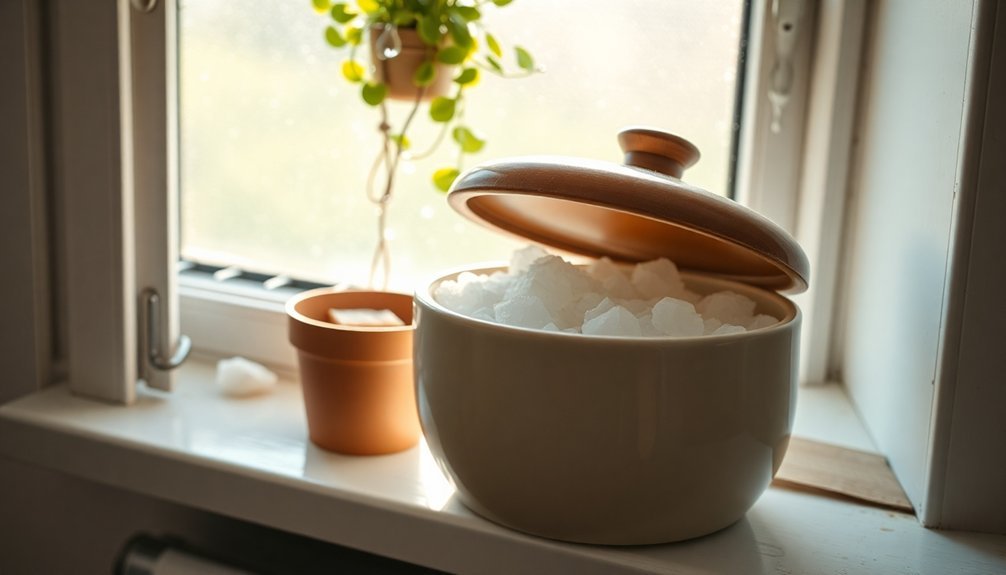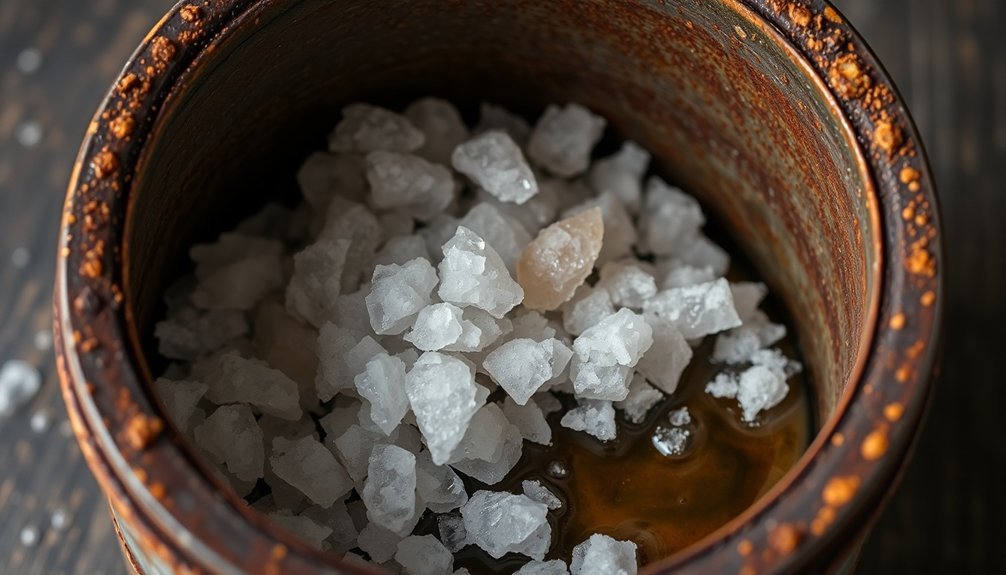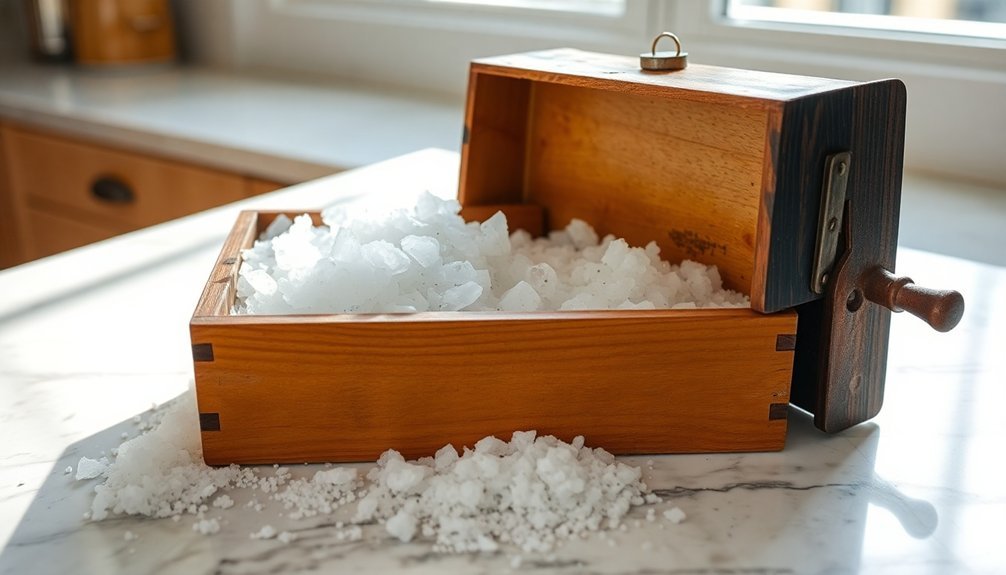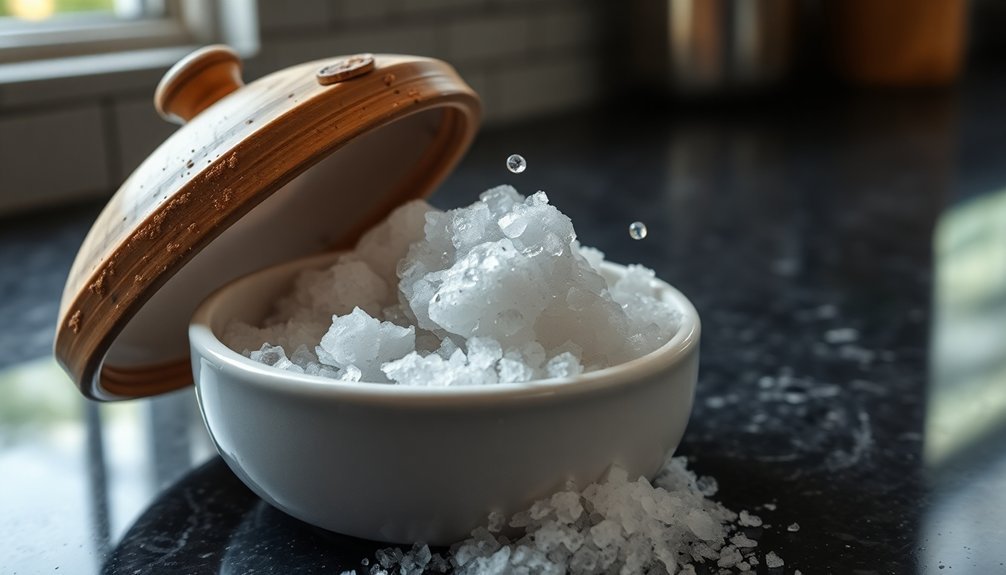Your salt box storage method probably has major flaws that are ruining your salt's quality. You're likely using a container that's not truly airtight, letting in moisture that causes clumping and contamination. The location matters too – if you've placed it near your stove or in a humid spot, you're accelerating the damage. Common mistakes include choosing porous materials like terra cotta, neglecting proper seals, and ignoring temperature fluctuations. Even your daily-use salt box needs proper maintenance and monitoring to prevent moisture infiltration and odor absorption. Understanding the right storage techniques will transform how your salt performs in the kitchen.
Common Salt Box Storage Mistakes

Salt's proper storage is often overlooked, leading to common mistakes that can compromise its quality and usability. You're likely making several errors in your salt storage method without realizing their impact on your seasoning's effectiveness.
If you're keeping your salt in an improperly sealed container, you're allowing moisture to seep in, which leads to clumping and degradation. Your kitchen's humid environment, especially during cooking, can worsen this issue. When you don't use an airtight container or choose one with a poorly fitting lid, you're exposing your salt to damaging airflow and moisture absorption. Salt's ability to serve as a natural preservative makes proper storage even more crucial for maintaining its effectiveness.
You might also be ignoring salt's hygroscopic nature by storing it in unsuitable materials. If you're using cardboard containers or metal boxes, you're risking contamination and corrosion. The cardboard absorbs moisture, while metal can react with salt's corrosive properties.
You're making a mistake if you're not storing your salt in a cool, dark place away from strong odors. Additionally, if you haven't considered using desiccants like uncooked rice in your salt container, you're missing an effective way to combat moisture absorption.
Choosing Your Storage Container Right
For effective salt storage, selecting the right container is essential to maintaining quality and preventing moisture damage. You'll want to focus on non-porous materials that can seal tightly while avoiding metals and porous options like terra cotta that can compromise your salt's quality. UV treated materials provide superior protection against environmental damage and deterioration.
| Material Type | Benefits | Considerations |
|---|---|---|
| Glass | Non-porous, clear visibility | Can break if dropped |
| Glazed Ceramic | Durable, attractive | Must guarantee proper glazing |
| Dense Wood | Natural aesthetic, durable | Needs proper sealing |
| Food-Grade Plastic | Lightweight, unbreakable | May retain odors |
| Porcelain | Elegant, non-porous | More expensive option |
When selecting your container, confirm it features a wide mouth for easy access and an airtight seal to prevent moisture infiltration. You'll find swivel lids with magnetic closures particularly convenient, as they allow for one-handed operation while maintaining a secure seal. If you're storing multiple types of salt, consider using several smaller containers rather than one large one. For long-term storage, you'll need larger containers with proper sealing mechanisms, but keep your everyday salt in compact, easily accessible containers that won't clutter your counter space.
Location Matters For Salt Storage

When choosing a storage spot for your salt box, you'll want to select high areas that stay naturally dry and offer protection from moisture accumulation.
Keep your salt container away from heat sources like furnaces or radiators, as these can create temperature fluctuations that lead to condensation.
While basements might seem convenient, they're typically too damp for salt storage and can compromise the salt's effectiveness. Your location selection should include considerations for proper drainage systems to prevent harmful runoff into nearby water sources.
High Areas Stay Dry
Choosing the right location for salt storage plays an essential role in keeping your supplies dry and protected.
You'll need to focus on elevation as a key factor in your storage strategy. Don't place your salt storage in low-lying areas where water can collect and potentially compromise your supplies.
Instead, store your salt on elevated pads or surfaces that naturally promote water drainage. You'll want to verify your storage location is at least 300 feet away from any streams, rivers, lakes, ponds, or wetlands, and completely outside the 100-year floodplain.
Keep a minimum distance of 100 feet from storm drains and ditches, and 300 feet from water wells to prevent contamination.
Your storage area must include an impervious pad that prevents salt from seeping into the ground.
Add berms, walls, or slopes around the pad to create secondary containment that controls both runoff and run-on.
Don't install floor drains in your storage area, as they can allow salt to enter water systems.
Away From Heat Sources
The proper location for salt storage requires careful attention to heat exposure and temperature control. You'll want to maintain a consistent room temperature between 60°F and 75°F to preserve your salt's quality. Keep your salt box away from stoves, ovens, and direct sunlight, as these heat sources can cause moisture buildup and degradation.
| Heat Source | Impact | Prevention |
|---|---|---|
| Sunlight | UV damage, iodine loss | Use opaque containers |
| Stove/Oven | Temperature fluctuation | Store away from cooking areas |
| Humid Areas | Clumping, moisture absorption | Use airtight containers |
| Kitchen Activity | Increased humidity exposure | Choose low-traffic storage spots |
Your salt's longevity depends on choosing the right storage location. Place your salt box in a cool, dry pantry or storage room where temperature remains stable. Don't store it near areas with strong cooking odors, as salt can absorb surrounding smells. If you're using a kitchen cabinet, select one that's far from heat-generating appliances and water sources. Check your storage containers regularly for signs of moisture or pest intrusion, and confirm they maintain an airtight seal to protect against humidity.
Avoid Basement Storage
Storing salt in basements poses significant risks to both your storage facility and the environment. When you store salt in basement areas, you're creating direct contact between the salt and groundwater sources, which can lead to serious contamination issues.
Your basement's proximity to the water table makes it particularly vulnerable, as salt can easily leach into groundwater systems and affect drinking water supplies.
You'll want to avoid basement storage because it violates several key regulatory requirements. Storage facilities must maintain a minimum distance of 300 feet from potable water wells and groundwater sources, which isn't possible with basement locations.
Additionally, you're required to have proper drainage systems and impermeable bases – features that are difficult to implement effectively in basement settings. If you're storing more than 100 tons of salt, you'll need to comply with specific siting recommendations that typically exclude basement locations.
Instead, you should opt for above-ground storage facilities with proper impermeable bases and coverage. This helps you maintain compliance with environmental regulations while protecting both groundwater resources and your facility's structural integrity.
Signs Your Salt Box Failed
Your salt box has failed when you notice telltale signs of moisture damage, including clumping, dampness, or visible condensation on the container's surface.
You'll also want to watch for evidence of air exposure, such as salt absorbing odors from the environment or becoming discolored over time.
These warning signs mean it's time to transfer your salt to a new, properly sealed container and reassess your storage method to prevent future damage.
Moisture Damage Warning Signs
Identifying moisture damage early can prevent ruined salt and damaged storage containers. You'll notice several key indicators when your salt box has been compromised by moisture.
Watch for salt that's becoming clumpy or forming solid chunks, as this is one of the earliest signs of moisture infiltration. If you spot visible condensation inside the container or detect rust forming on metal surfaces, you're dealing with significant moisture problems.
Pay attention to changes in your salt's texture and usability. When you can't easily measure or dispense salt due to hardening, or if you notice an unusual smell or taste, moisture has likely contaminated your storage.
Check your container regularly for structural issues that allow moisture to enter, such as cracks, gaps, or loose lids.
Don't overlook environmental factors contributing to moisture damage. If you're storing your salt box in humid areas, near heat sources, or in poorly ventilated spaces, you're risking moisture accumulation.
Inspect your container's seal integrity frequently, and look for signs of material degradation. When you spot these warning signs early, you can take immediate action to protect your salt and prevent further damage.
Air Exposure Red Flags
Vigilance in monitoring your salt box's condition can reveal air exposure problems before they become serious. Your first warning sign is when salt begins to clump or harden – this happens because it's absorbing moisture from the air, especially in humid environments.
While clumping doesn't affect taste, it'll make your salt harder to use.
You'll notice your salt taking on unwanted odors if it's exposed to strong-smelling foods or substances. Since salt naturally absorbs odors, keeping it near garlic, fish, or other aromatic items will compromise its flavor.
Watch out for temperature fluctuations and light exposure too – they're particularly harmful to iodized salt, causing iodine loss and accelerating moisture absorption.
Don't ignore signs of contamination or corrosion. If you're using a metal container, look for rust or deterioration since salt's corrosive properties can damage the storage vessel.
Check for any dust, dirt, or oil that might've gotten into your salt – these contaminants can ruin your entire supply.
You'll want to transfer your salt to a non-metal container if you spot any corrosion and guarantee it's stored in a clean, dry environment.
Best Materials For Salt Boxes

Quality materials make all the difference when selecting a salt box for your kitchen. You'll want to focus on non-porous options that resist moisture and maintain your salt's freshness. Dense woods like acacia, ash, or olive wood are excellent choices, especially when treated with food-safe shellac.
Bamboo offers a lightweight yet durable alternative that's environmentally conscious.
If you're considering ceramic options, glazed stoneware and porcelain provide reliable protection while adding aesthetic value to your kitchen. These materials won't absorb moisture and are easy to clean, making them practical for daily use.
However, you'll need to avoid materials that can compromise your salt's quality. Stay away from terra cotta, which absorbs moisture, and metals like steel or copper that can corrode over time.
When choosing your salt box, look for features that enhance usability, such as hinged or sliding lids that allow easy access. The size should comfortably fit your hand, and the design should be compact enough for convenient storage.
If you opt for wooden containers, make certain they've continuous grain patterns and are properly sealed to prevent moisture absorption.
Moisture Control Tips That Work
While selecting the right salt box material sets the foundation, proper moisture control determines how well your salt stays free-flowing and fresh. You'll need to implement multiple strategies to keep moisture at bay, starting with proper container selection and effective desiccant use.
| Strategy | Method | Benefit |
|---|---|---|
| Container Choice | Airtight with screw-top or Gamma Seal | Minimizes air and moisture entry |
| Desiccant Use | Silica gel packets or silicate absorbers | Maintains dry environment |
| Location Control | Cool, dry area away from sunlight | Prevents moisture accumulation |
| Humidity Management | Salt packs or DIY humidity controls | Stabilizes relative humidity |
Don't skip using desiccants – they're your first line of defense against moisture. Place them in your container, but keep them from directly touching the salt. You'll want to check and replace these regularly to maintain their effectiveness. When handling your salt, always use a dry scoop or spatula to minimize moisture introduction. If you're in a particularly humid climate, consider using multiple moisture control methods simultaneously. For example, combine desiccants with a saturated NaCl solution humidity controller to maintain ideal storage conditions around 75% RH.
Daily Versus Long Term Storage

For effective salt storage, you'll need different approaches depending on your timeframe and usage patterns. Your daily storage solution should focus on convenience and accessibility, while long-term storage requires more careful planning and protective measures.
For daily use, select a salt box made from durable materials like bamboo, olivewood, or acacia. Choose designs with swivel covers for easy access, and consider divided boxes if you're storing multiple salt types.
While glass containers work, they're more fragile and require careful handling. You'll want to keep your salt box clean and the lid tightly closed to maintain freshness.
Long-term storage demands a different strategy. You'll need airtight containers like glass jars, food-grade plastic buckets with Gamma Lids, or Mylar bags to prevent moisture absorption.
Store these containers in cool, dry, dark locations like basements or root cellars. Pure forms of salt, such as sea salt and Pink Himalayan, will last indefinitely when stored properly, though iodized salt has a shorter shelf life due to additives.
Label your containers with packaging dates and check periodically to verify your salt remains dry and clump-free.
Frequently Asked Questions
Can Salt Absorb Toxic Chemicals From Plastic Containers During Long-Term Storage?
Yes, your salt can absorb toxic chemicals when stored in plastic, especially PVC, LDPE, or HDPE containers. Salt's interaction with these plastics causes degradation and chemical leaching, particularly over long storage periods.
How Often Should Wooden Salt Boxes Be Treated With Mineral Oil?
You'll need to treat heavily used wooden salt boxes monthly with mineral oil, while less frequent use requires treatment every 6-12 months. Watch for signs of dryness or fading to determine when it's time.
Does Storing Different Salt Varieties Together Affect Their Individual Properties?
Yes, when you mix different salts, they can affect each other's properties. You'll find that moisture absorption varies between types, anti-caking agents can transfer, and different grain sizes can blend, altering their intended uses.
Can Electromagnetic Fields From Appliances Affect Salt's Mineral Content Over Time?
You don't need to worry about appliances affecting your salt's mineral content. The electromagnetic fields they produce are too weak to cause significant changes to salt's structure or mineral composition over time.
Should Himalayan Salt Be Stored Differently Than Regular Table Salt?
You'll want to store your Himalayan salt similarly to table salt, but pay extra attention to moisture control since it's more hygroscopic. Use airtight glass or ceramic containers and keep it away from light.
In Summary
You've learned the critical mistakes that can ruin your salt storage and how to avoid them. Now it's time to put these tips into action. Choose the right container, place it in an ideal spot, monitor for warning signs, and control moisture levels. Whether you're storing salt daily or long-term, proper storage will keep your salt dry, fresh, and ready to use whenever you need it.





Leave a Reply